The following information on Smith & Wesson .22 Revolvers comes from Smith & Wesson Hand Guns by Roy C. McHenry and Walter F. Roper. Smith & Wesson Hand Guns is also available to purchase in print.
Determined attempt to step up the velocity of existing types and calibers of cartridges has been made since about 1930. Remington-UMC designed a new .22 long rifle cartridge with a smokeless powder charge and a brass case-instead of the copper case which had contained the mild Lesmok powder to the satisfaction of small-bore shooters for so many years.
Hitherto a dependable, low-velocity affair, the new .22 long developed 1,400 f.s. when fired from a rifle. But the cartridge proved too robust for lighter types of rifles and disastrous results followed its use in pistols and revolvers. Lack of lateral support caused the brass case to blow out around the rim, where it joins the body of the case.
Most revolver manufacturers passed up the Remington Hi-Speed cartridge as hopeless, but Major D. B. Wesson (not Daniel but Douglas) continued his experiments with the dangerous little contraption. Success finally crowned his efforts when he re-discovered the expedient of the cylinder with countersunk recesses to provide support for the cartridge rims.
Major Wesson’s idea was ingenious but not original. Gunsmiths of the pre-Civil War period had resorted to the same expedient in adapting cap-and-ball revolvers to shoot rim fire cartridges, although it is a question whether they were seeking lateral support for the cartridge heads or simply a closer fit between the back of the cylinder and the recoil shield.
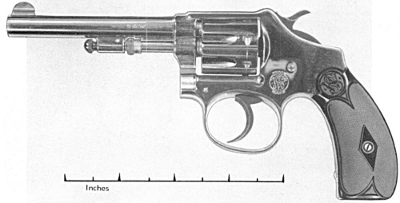
Having solved the primary problem, Major Wesson lost no time in designing a revolver to shoot the Hi-Speed cartridge. There had been a steady demand for heavier hand guns to shoot .22 cartridge ever since Colt introduced the Camp Perry single-shot pistol. Smith & Wesson’s .22/32 was also called the Heavy Frame .22, but it weighed only 23 ounces. Next in size was the .38 Military & Police Model with a weight of 31 ounces and a six-inch barrel. It was a simple matter to have the cylinder and barrel of the .38 bored to accommodate the .22, and with the excess metal its weight came to 35 ounces—a good heft for a target revolver and several ounces above any other .22 on the market at the time. Another feature that must have appealed to the firm’s financial supervisors was that the new gun did not require much new machinery or re-tooling to be placed in production.
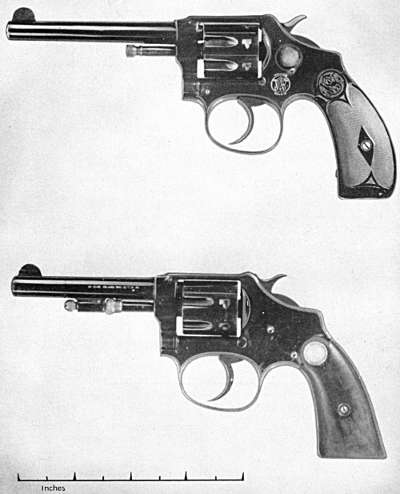
Major Wesson either overlooked or ignored one point about the new revolver. A .22 long rifle cartridge is more than half an inch shorter than a .38 special, which meant that the .22 bullet had to travel that distance through the smooth-bore chamber before contacting the grooves in the barrel—a factor that to some small extent affects the weapon’s accuracy. However, machine rest tests showed that it would group its shots inside an inch-and-a-half circle, which should satisfy almost any shooter.
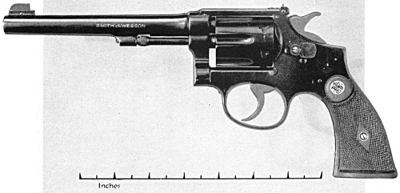
While it would be theoretically possible to rifle the intervening space in the chambers of this gun, the nicety of adjustment necessary to bring grooves and lands of chamber and barrel into exact conjunction would add perceptibly to the cost of production. It would also be possible to shorten the top strap and decrease the length of the cylinder, but this might spoil the balance of the revolver and would certainly detract from the harmony of its proportions. The same fault, if you choose to call it that, exists in the Colt Officers Model and its twin, the Colt Official Police Revolver, in .22 caliber. Both came out shortly after the Smith & Wesson K-.22 made its appearance and were likewise designed to ·shoot the hi-speed cartridge. Like the Smith & Wesson, they were supplied with the countersunk or embedded chamber, which is not a patentable feature.
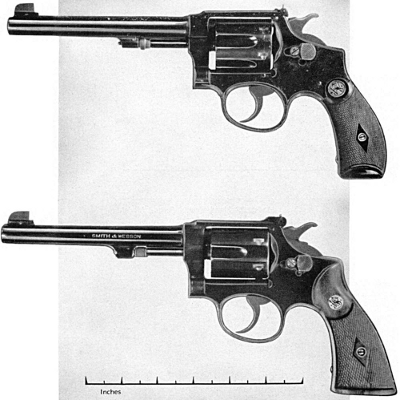
Below—Smith & Wesson .22 “Masterpiece.”
Aside from the natural increases in velocity due to substitution of smokeless for black powder, little attention was given cartridges of larger size until after 1930. Only one American hand gun cartridge was being produced with a speed above 1,000 f.s., and it had remained in comparative disuse since its introduction in 1904. This was the Colt .38 automatic, and its lack of popularity was due to the fact that the Colt Corporation had failed to provide anything to shoot it in other than the antiquated carpenter square-model which lacked a safety grip. The cartridge deserved better treatment for it had a velocity of 1,146 plus f.s. and energy and penetration exceeding the Mauser and Luger on account of its heavier 130-grain bullet. The few shooters who had acquired proficiency with the inconveniently balanced arm for which it was designed testified to its accuracy at long ranges; but it was not these enthusiasts who rescued the cartridge from comparative obscurity. It happened this way:
During the First World War a number of so-called “bullet proof” vests had been placed on the market and military authorities had experimented with some of them. But they were heavy and cumbersome in combat use and, besides, they were vulnerable against rifle fire. It was not until the post-war era of gangsters and hijackers that the bullet-proof vest became popular with denizens of the underworld, who discovered that the garment was proof against a revolver or automatic bullet not exceeding 900 f.s. velocity. This included the .45 automatic which police of that day were using for serious business and they began to report instances of hoodlums moving away under their own power who apparently had been hit dead center.
Eventually the mystery was solved when one of the law-enforcing agents brought down his man with a head shot and ascertained that he had been wearing one of the protective vests. Tests followed which proved that current regulation hand gun equipment was no match for the armored garment, so the authorities took their problem to the Colt experts.
Colt continued the experiments and found that the vest stopped every bullet in stock, including the .45 Peacemaker, except the neglected .38 automatic. This cartridge drilled a neat hole through the vest, but to make doubly sure they increased the velocity of the cartridge to 1,300 f.s.—which was very little trouble in view of the increased efficiency of smokeless pistol powder.
From their researches emerged the cartridge known as the .38 Superautomatic, and as the archaic Model 1902 pistol was obviously unsuitable for police work they designed for it a new weapon by reducing slightly certain dimensions of the .45 automatic. The new .38 automatic was adopted by a number of police organizations, including the Federal Bureau of Investigation, for which it performed its armor-piercing functions to entire satisfaction.
Another use which police authorities found for hand guns with high penetrative power was the stopping of automobiles. Any pistol or revolver would shoot holes in “tin lizzies” and other lightly constructed cars of the period, but it was not long before the outlaw element began to use heavier automobiles for their nefarious purposes. Within a few years a type of glass was developed which would stop ordinary revolver bullets, even of heavy caliber. But the new Superautomatic cartridge had no trouble boring through metal and safety glass with enough surplus energy to kill or maim the occupants.
As may naturally be supposed, officers and directors of the Smith & Wesson Corporation were not happy to see their regular police customers leaving them, while road patrols and raiding squads equipped themselves with the new Colt automatic. In other years the .38 K Model Smith & Wesson had been a popular police arm, but its ammunition lacked the energy to tear through trick vests, heavy car bodies and bullet-proof glass. Along in 1933, Vice-President Douglas B. Wesson decided to do something about it.
We can imagine him at his desk with a Colt .38 Superautomatic cartridge and a .38 Smith & Wesson cartridge before him. Bullet diameters were substantially the same, .359″ for the Colt and .357″ for the S&W. Weight advantage went to the Special, 158 grains to 130, but the Colt had a velocity of 1,300 f.s;, energy of 487 pounds and would penetrate ten 7/8″ pine boards at 15 feet. The Special’s velocity was only 847 f.s., its energy 252 pounds, and its penetration power eight and one-half inches of the same pine boards. Comparisons are said to be odious, but Major Wesson did not flinch from making them. And like his grandfather, he kept on making them until he found what he was seeking.
Placing the two cartridges on end, side by side, he saw that the S&W was taller, 1.55″ as against the Colt’s 1.27″. This was due in part to the Special’s larger bullet, but the scale showed that the Special’s case was a hair’s breadth over a quarter of an inch longer, leaving that additional space for powder stowage.
The major recalled that the .38 S&W originally had been a black powder cartridge holding a charge of 26 grains. Its velocity had been stepped up when the load was changed to smokeless, but not a great deal. He picked up the cartridge and shook it, the vibration convincing him that it was not packed to capacity as it had been in the black powder days. The automatic cartridge, he reflected, had always been loaded with smokeless powder and was packed to capacity, or nearly so. When he had finished his examination he knew there was room in the .38 Special case for enough high voltage powder to wreck any revolver in existence.
Experiments proved that the heat-treated cylinders of existing revolvers were proof against the Superautomatic or the pepped-up Special, but that another element was inadequate. Human endurance balked at a weapon which almost kicked itself out of the shooter’s hand. It was the story of the first .45 Colt single-action all over again, when the first cartridges with the 40-grain charge were fired. The kick of the old Peacemaker had made shooters flinch, but the .38’s threatened to fly over the shooter’s shoulder.
No such trouble had been experienced with the Superautomatic in the gun designed for it, whose recoil (or a large portion of it) had been utilized for throwing back the slide and ejecting the cartridge case. But in revolvers this energy is wasted—or rather, makes a nuisance of itself.
Only solution to the problem was to build a gun capable of absorbing part of the recoil by the inertia of its weight. Major Wesson consequently fitted a .44 frame with barrel and cylinder bored for the .38 and found that the additional mass modified the gun’s tendency to dislocate the shooter’s shoulder. A five-inch barrel was chosen as the best length for a reasonably quick draw and, as an afterthought, addition was made of the casing that had been used around the front cylinder stop of the New Century Model.
To minimize further the back chop of the narrow frame, a metal “adaptor” was designed which partly filled the space below the trigger guard. This improved the grip by providing a firmer hold, but still left something to be desired. When finally placed in production, it was designated as the .38/44 Heavy Duty Revolver and weighed 40 ounces, which was not excessive for quick work. Being designed as a police arm, it was fitted with fixed sights.
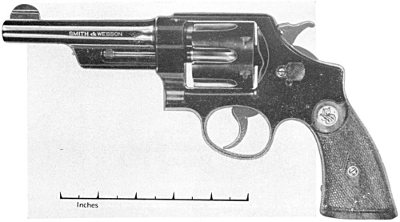
As the cartridge proved to be very accurate, the gun was also produced in a target model with a 6 1/2-inch barrel and adjustable sights, in which form it weighs 41 3/4 ounces and is known as the .38/44 Outdoorsman.
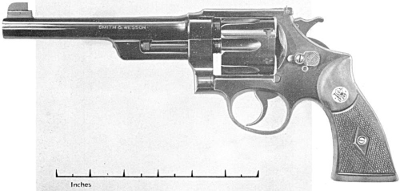
The Heavy Duty Model and the cartridge designed for it proved to be a highly effective combination for combating crime. It penetrated bullet-proof vests with destructive power; it pierced the back of a heavy automobile, ranged forward through upholstery and inner fittings and even damaged the engine. A special metal-piercing type of bullet was designed for the cartridge shaped something like the “ferrule point” on arrows used by expert archers, resembling an obtusely sharpened pencil. In conformance with Smith & Wesson’s traditional regard for the bore of their revolvers, the jacket of the bullet is so applied that it does not touch the rifling. As in the .35 automatic cartridge, the bullet is of lead at its extreme diameter, thus avoiding the wear usually caused by cased bullets.
Besides being used successfully on hardened criminals, the Heavy Duty Model is effective on big game. Jack Tooker, who formerly was employed by the government to keep down the population of predatory animals in Grand Canyon National Forest, used it to kill mountain lions and rarely had to expend more than one round per varmint. But unless you have had as much experience in this line as Mr. Tooker, you should take a dependable rifle along with you when you are out after felis concolor.
